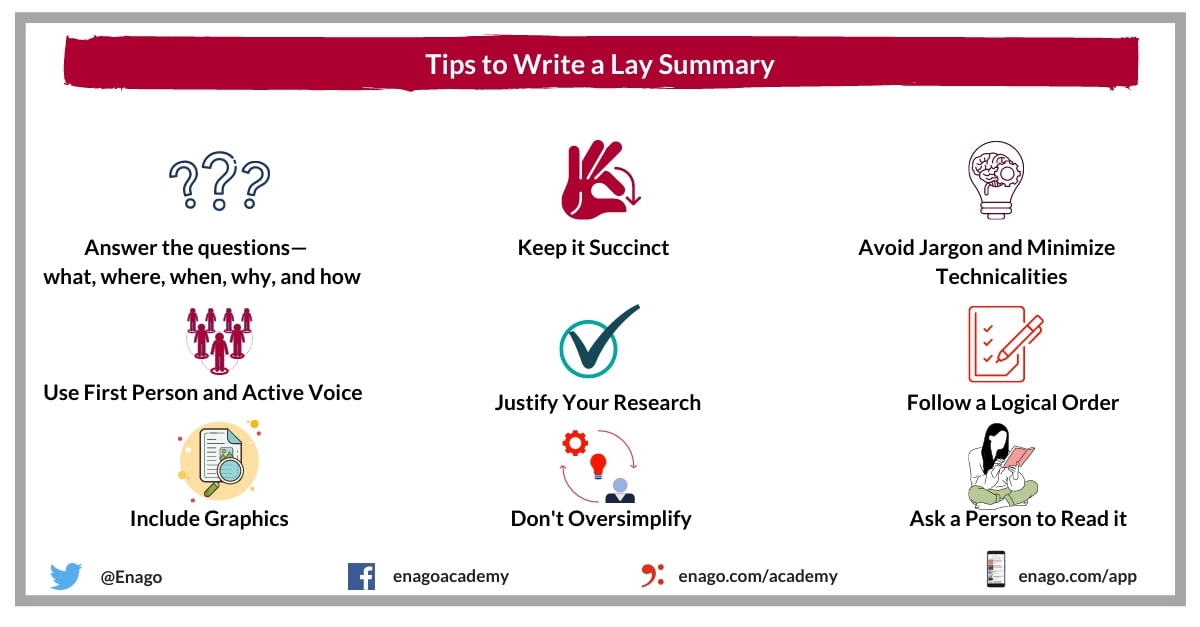What Makes a Great Lay Summary? – Top 09 Tips to Write One!

Scholarly publishing forms an integral part of research communication. Hence, after having spent endless hours in research conduction, you must plan on publishing it. There’s an increasing pressure dwelling in every researcher’s mind to break academic barriers and easily communicate their findings to not only academic but also non-academic audience. What makes a researcher’s way to reaching out to the lay man is by writing a lay summary!
You’d wonder why must you write a lay summary? Generally, organizations and taxpayers fund research. These people could be non-scientists. Such people would require to understand the real-world impact of your research, and it’s therefore imperative for you to write a summary in a language that is easily comprehendible to all audiences. On the other hand, it is very important for researchers to not only publish their research work for specific audience but also demonstrate the impact of their research by sharing it widely. In this post, we will discuss how to write excellent lay summaries and the benefits and opportunities they hold.
What is a Lay Summary?
While your peers and journal target audience would probably be cognizant of your research topic and the article you write, its content may probably be incomprehensible to the lay man or woman on the street. In addition, researchers are often asked by their universities and funders (especially) to draft an overview of the impact of their research for the general people who are beyond specific research area.
A lay summary, as its name indicates, is an efficient way of conveying the crux of your research article concisely and clearly. In general, it is a brief paragraph that outlines your manuscript and is aimed to disseminate the impact of your research to wider non-specialists in the field. This intent of a lay summary differentiates it from abstract, which is written for a subject-specific audience. Furthermore, due to its non-technical and concise nature, a lay summary should be around 200-250 words to convey the essence of your research using simple language.
Top 09 Tips on How to Write a Lay Summary
 1. Answer the questions—what, where, when, why, and how
1. Answer the questions—what, where, when, why, and how
Your summary must clearly answer questions related to your research for easy comprehension by all readers.
2. Keep it Succinct
Write in simple English keeping all the relevant information. For a better approach, imagine that you are explaining your research to a distant family member who does not have a scientific background.
3. Avoid Jargon and Minimize Technicalities
Use regular English words and get rid of complex terms which can be replaced with simpler words. For example, use ‘nerves’ instead of ‘neurons’ and ‘cell death’ instead of ‘apoptosis’
4. Use First Person and Active Voice
Use person centered language. For example, use “we agreed” instead of “it was agreed”.
5. Justify Your Research
Explain how your research will help in solving real-world problems. Predict and cover its potential impact on society.
6. Follow a Logical Order
Ensure well organization of the summary. Furthermore, explain every aspect of your research clearly. Do not jump to conjectures. This may confuse the reader.
7. Include Graphics
Incorporating one or two images can make it easier for non-academic readers to comprehend your research in a better way.
8. Don’t Oversimplify
While trying to make it simple, ensure that the crux of your research is not missed out. The reader must clearly understand what the research is about and how it will affect the society.
9. Ask a Peer and a Non-scientist Person to Read it
It is imperative to let your peer read the lay summary to make sure that the science is correct; whereas, a non-academic friend or family member will let you know if it is easy to understand and clearly explains your research goals. If they have questions after reading it then you will have to revamp it.
Why Should You Write a Lay Summary?
As researchers are always swamped with other research and writing related activities for a specific target audience, they find it difficult to commit the time and effort to learn skills and write a summary in a simpler language for a wider audience. Hence, for researchers to devote extra time and effort in learning a new skill, they must believe that public engagement is a possible approach to improve the relevance and impact of their research work.
The benefits of writing a lay summary:
- Lay summaries help you garner wider readership
- Help funding bodies to provide evidence how taxpayers’ contributions are utilized
- It helps funders to clearly and accurately communicate with mainstream media
- Clear dissemination of accurate information provides recognition in academic as well as non-academic fields
- Additionally, lay summaries demonstrate the potential of your research to policymakers resulting in an increase in public spending on research
- More importantly, lay summaries enable grant reviewers to evaluate the potential real-world applications and impact of research on society.
Isn’t drafting a great lay summary easier now? Follow these tips to write a lay summary and improve public understanding of research, increase your research visibility, and garner the attention of potential funders. Let us know what’s your biggest struggle while writing lay summaries in the comments section below.









